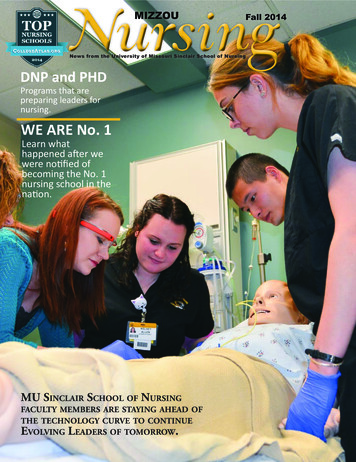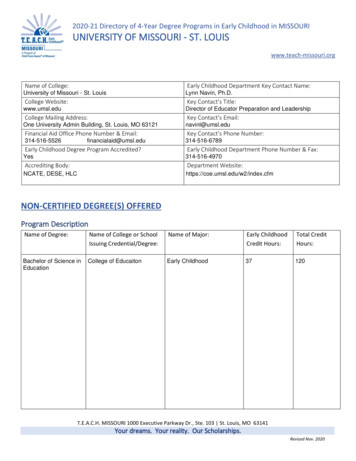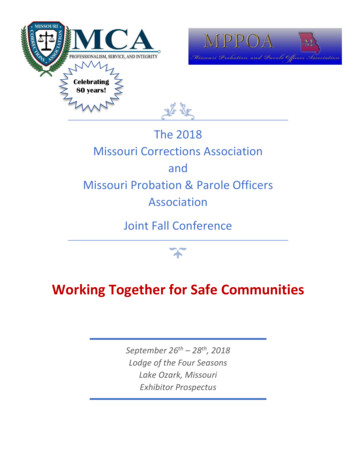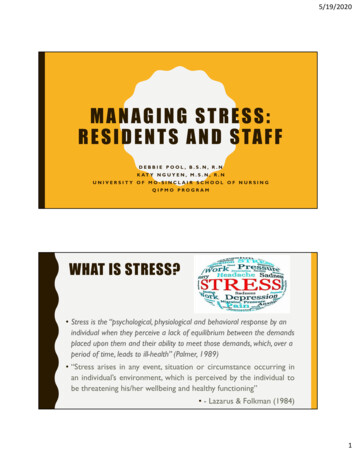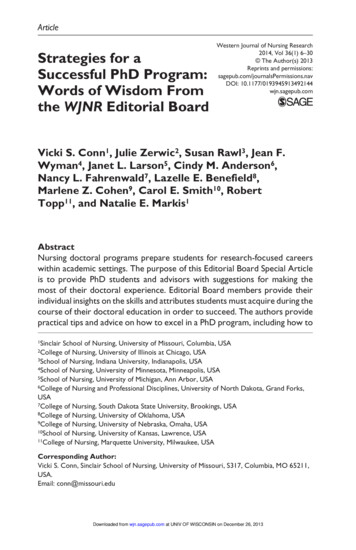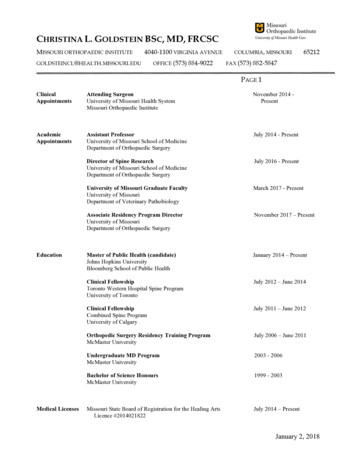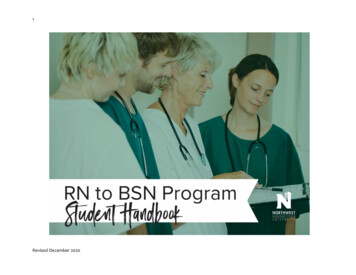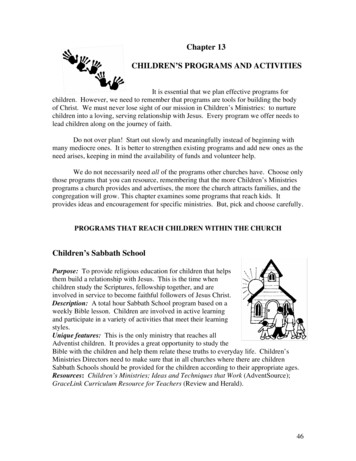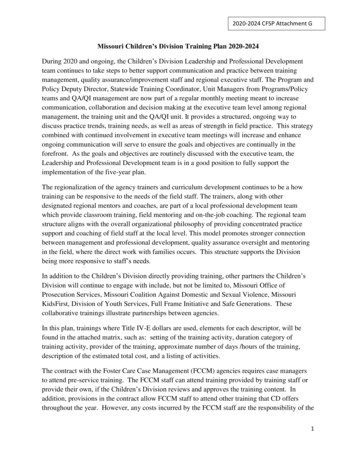
Transcription
2020-2024 CFSP Attachment GMissouri Children’s Division Training Plan 2020-2024During 2020 and ongoing, the Children’s Division Leadership and Professional Developmentteam continues to take steps to better support communication and practice between trainingmanagement, quality assurance/improvement staff and regional executive staff. The Program andPolicy Deputy Director, Statewide Training Coordinator, Unit Managers from Programs/Policyteams and QA/QI management are now part of a regular monthly meeting meant to increasecommunication, collaboration and decision making at the executive team level among regionalmanagement, the training unit and the QA/QI unit. It provides a structured, ongoing way todiscuss practice trends, training needs, as well as areas of strength in field practice. This strategycombined with continued involvement in executive team meetings will increase and enhanceongoing communication will serve to ensure the goals and objectives are continually in theforefront. As the goals and objectives are routinely discussed with the executive team, theLeadership and Professional Development team is in a good position to fully support theimplementation of the five-year plan.The regionalization of the agency trainers and curriculum development continues to be a howtraining can be responsive to the needs of the field staff. The trainers, along with otherdesignated regional mentors and coaches, are part of a local professional development teamwhich provide classroom training, field mentoring and on-the-job coaching. The regional teamstructure aligns with the overall organizational philosophy of providing concentrated practicesupport and coaching of field staff at the local level. This model promotes stronger connectionbetween management and professional development, quality assurance oversight and mentoringin the field, where the direct work with families occurs. This structure supports the Divisionbeing more responsive to staff’s needs.In addition to the Children’s Division directly providing training, other partners the Children’sDivision will continue to engage with include, but not be limited to, Missouri Office ofProsecution Services, Missouri Coalition Against Domestic and Sexual Violence, MissouriKidsFirst, Division of Youth Services, Full Frame Initiative and Safe Generations. Thesecollaborative trainings illustrate partnerships between agencies.In this plan, trainings where Title IV-E dollars are used, elements for each descriptor, will befound in the attached matrix, such as: setting of the training activity, duration category oftraining activity, provider of the training, approximate number of days /hours of the training,description of the estimated total cost, and a listing of activities.The contract with the Foster Care Case Management (FCCM) agencies requires case managersto attend pre-service training. The FCCM staff can attend training provided by training staff orprovide their own, if the Children’s Division reviews and approves the training content. Inaddition, provisions in the contract allow FCCM staff to attend other training that CD offersthroughout the year. However, any costs incurred by the FCCM staff are the responsibility of the1
FCCM contractor. The Children’s Division does not cover travel or per diems associated withthese trainings.Professional Development and TrainingThe Children’s Division Leadership and Professional Development team coordinates andsupports the development and delivery of initial and ongoing in-service training programs withinthe regions for new Children’s Service Workers, supervisors and managers. Training is directlyprovided to various levels of staff throughout the 46 circuits in the state of Missouri. Thetraining developed is based on agency policy and best practice and is designed and coordinatedto provide a consistent core structure, while also providing ongoing opportunities based on needsidentified through individual, circuit or region specific assessment, as well as professionaldevelopment plans between staff and front line supervisors. The professional development ofstaff is considered to be a “system” within the agency and must rely on numerous key elementsworking in concert together including classroom training, on-the-job training, and reinforcementof clinical skills in the field between staff and the first line supervisor. The agency supports a“blended learning” approach, utilizing classroom, on-the-job field instruction, as well as online/self-instruction “eLearning” training which supports and supplements the classroom trainingand on-the-job training. The training unit also collaborates in the development and delivery oftraining programs with many other agencies and disciplines who serve children and families.Trainings are conducted in geographic locations throughout the state to accommodate staff andcommunity partners.How Ongoing Training is selected and provided to ensure the Competencies of Workers,Supervisors, Managers and AdministratorsThe Children’s Division Leadership and Professional Development team and regionalprofessional development teams are responsive, on a continual basis, to meet the on-goinglearning needs of staff. Changes in training are based upon the needs of the agency and availableresources such as budget, staffing etc. Training needs, both individual and statewide, areassessed and evaluated in several different ways throughout the year as a way to be responsive toimmediate needs of a region or circuit, but to also address policy and practice changes that havea larger statewide impact. On-going training needs are identified through: Continuous Quality Improvement (CQI) processes Training evaluations Training & policy staff joint review Exit interviews Focus group feedback2
Recommendations from the Supervision Advisory Committee The Division Executive TeamAll the above are considered when developing new training or enhancing existing curriculum.Individual needs are identified using various methods such as the ENGAGE and REFLECTemployee performance evaluation and development process and on-the-job coaching tools.Based upon identified needs, staff and their supervisors mutually select internal and/or externaltrainings to address individual learning needs.Workers receive in-service training related to their specific program area, such as RSMo Chapter210 statutory requirements for child abuse and neglect investigations, and adoption trainingbased upon COA standards. Other program staff who provide Family-Centered Services or workwith the out-of-home care population receive ongoing training through outside trainingopportunities and through agency partnerships. Under the management training rule, all frontline supervisors and managers are required to complete 16 hours of in-service managementtraining each year thereafter. This is done through department course offerings and outsidetraining opportunities.All of the above on-going training is tracked through the agency Employee Learning Center(ELC).How Skill Development of new and experienced staff is measuredSkill development of new and experienced staff is measured in a variety of ways using severaldifferent methods. Skill development and attainment is reviewed throughout classroomcoursework, during on-the-job training, and through interactions between staff and theirsupervisor. The following are several different ways this is accomplished: On-the-Job Coaching (OJC) — On-the-job coaching activities are part of the transfer oflearning process and new workers must be allowed time and support in completing theseactivities. In order for classroom training to have an effect on practice, participants mustuse their newly acquired skills in the work setting in the performance of OJC activities.Supervisors must ensure that new workers have an opportunity to do all the assigned OJCactivities. Coaching and modeling by the supervisors are important components of theOJC process. Worker skill and development level can be observed and assessed duringassigned OJC activities and the case consultation process. Case management decisionsmust be made jointly between the supervisor, OJC Specialist (when available in a region)and worker throughout Child Welfare Practice Training (CWPT). As skills are acquired,demonstrated, and applied, case work activities gradually increase with continuedsupervisory oversight.3
ENGAGE—ENGAGE focuses on leaders working with their team members asindividuals. ENGAGE establishes clear expectations and development goals for eachteam member. Team members receive regular feedback focused on how they areperforming to help them and their teams improve. Leaders also have the chance toexplain the organization’s direction and how team members’ work every day fits into thebig picture. ENGAGE helps team members understand their roles and contributions.These conversations are opportunities to step back from the day-to-day, reflect uponwork and skills, and chart a path forward to improve. Classroom evaluations—Staff participate in various activities and work during trainingand provide feedback using the classroom evaluation. This provides an opportunity forstaff to reflect on the following: did content address the worker skill level, and did thecontent help them gain the knowledge and skill necessary to do their job. Thisinformation is used to guide curriculum development to better impact skill development.Specific training conducted to help foster parents, relative guardians, adoptive parents, workersin group homes, and case managers understand and address the issues confronting adolescentspreparing for independent living.The following trainings assist foster parents, relative guardians, adoptive parents, and casemanagers in their understanding of issues confronting adolescents preparing for independentliving: STARS Pre-service Session Seven - Continuing Family Relationships (includes Preparingfor Young Adult Life & Another Planned Permanent Living Arrangement) STARS In-service Module 12 -Understanding and Promoting Preteen and TeenDevelopmento Session 1: Transitioning to Adulthood—Resilience, Risks, and Researcho Session 2: Developmental Tasks and the Impact of Trauma and Loss Ready, Set, Fly—‘Ready, Set, Fly! A Parent’s Guide to Teaching Life Skills’ wasdeveloped as a practical resource to help caregivers teach youth some of the skills neededto enable them to live successfully on their own. The activities are age appropriate anddevelopmental, matching the levels of the Ansell-Casey Life Skills Assessment andGuidebook (ages 8-10, 11-14, 15-18, and 19 and older). The six sections providecomprehensive, developmental activities in the areas of daily living tasks, housing andcommunity resources, money management, self-care, social development, and work andstudy skills. Older Youth Program - This information is part of the Child Welfare Practice Trainingfor front line staff and provides information for the participant to gain:4
o understanding of services/benefits/resources/opportunities of the Older YouthProgramo how to access services/benefits/resources and opportunities for the older youtho the philosophical base of the Division’s work with older youtho the worker’s role and responsibility as a youth’s worker in providing theopportunity for the youth to fully participate and benefit from theresources of the Older Youth Programo the role and responsibilities the youth have in the processo the role and responsibilities of the people and agencies collaborated with inproviding services to our youth***All of these training courses are referenced elsewhere in the plan except for ‘Ready, Set,Fly’, which is a curriculum used at the local level.On-the-Job CoachingNew staff must complete On-the-Job Coaching (OJC), which supports the classroom training.The OJC training activities are part of the learning process of the new worker and they must beallowed time and support in completing these activities. In order for classroom training to havean effect on practice, participants must use their newly acquired skills in the work setting in theperformance of OJC activities. The supervisor must ensure that new workers have anopportunity to do the assigned OJC activities referenced in the guide. Each region has an OJCguide developed for front line staff with required activities to be completed.Completion of OJT is also acknowledged and tracked through the Employee Learning Center(ELC). The ELC is used to track enrollments, wait lists, completion of training, assignedcurricula, training plans, and create gap analysis reports.Training Provided to New Child Welfare Workers - Child Welfare Practice TrainingThe initial in-service curriculum is titled Child Welfare Practice Training (CWPT). This trainingis provided to new Children’s Division staff and new contracted agency staff. Professionaldevelopment begins when an employee starts employment with The Children’s Division. Thefirst year of a new employee’s professional development is comprised of formal, classroomtraining mixed with on-the-job coaching. The formal, classroom training is provided by regionalstaff trainers and the on-the-job coaching is provided by local supervisors or specialist in theemployee’s own area, often unique and individually tailored to the professional developmentneeds of that employee.5
The following describes how the initial/pre-service regional training curriculum addresses issuesof safety, permanency and wellbeing.Jackson CountyJackson County operates a five week combination of classroom/field experience trainingprogram. New employees begin Child Welfare Practice Training, within two weeks ofemployment. New workers attend formal classroom training two days every week for fiveweeks. When not in classroom training, the employee and their supervisors use a “TrainingPassport” that consist of field experiences, group activities, and field trips to enhance theirclassroom learning. After the first two weeks of training, Jackson County bifurcates andprovides specialized training to new employees along program lines of case management orinvestigation/assessments. Jackson County Training Region provides a total of 96 hours of onthe-job training and 87 hours of classroom training. The Field Support Manager supervising theregional professional development team has oversight responsibility to be sure all new hiresreceive training timely. Jackson workers become case carrying after the pre-service training iscomplete.Jackson County regional training structure currently consists of: 17 hours of Philosophy and Skills classroom trainingThis skill based curriculum will introduce the participant to the agency’s mission andprincipals; code of ethics, strengths based practice, Five Domains of Wellbeing, culturalcompetency, and a variety of family assessment tools.18 hours of On-The-Job Training21 hours of Philosophy and Skills classroom trainingThis skill base curriculum will introduce participants to critical thinking skills andprovide participants the opportunity to practice the use of these skills. Participants will beintroduced to Signs of Safety and have the opportunity to practice using this model;participants will learn skills used to work within a team, how to further assess for safety,and how to apply these skills to their fieldwork. Participants will learn basics of reportwriting and court testimony. Participants will begin to practice obtaining records andmaintaining confidentiality.16 hours of On-The-Job Training14 hours of Child Abuse and Neglect or Case Management classroom trainingCase Management: This skill based curriculum will strengthen critical thinking skills,and apply them to case management. Participants will get the opportunity to practiceinterviewing and report writing. Participants will strengthen their knowledge in the Signsof Safety and permanency planning. Participants will be introduced to writing summaries,factual documentation, and court reportingInvestigations: This skill based curriculum will strengthen critical thinking skills, andapply them to CA/N investigations. Participants will get the opportunity to practice6
interviewing and report writing. Participants will strengthen their knowledge in Signs ofSafety. Participants will be introduced to conclusion writing, factual documentation, andcourt report writing.24 hours of On-The-Job Training14 hours of Child Abuse and Neglect or Case Management classroom training (including6.5 hours of automated case management training)Case Management: This skill based curriculum will strengthen critical thinking skills,and apply them to case management. Participants will get the opportunity to practiceinterviewing and report writing. Participants will strengthen their knowledge in Signs ofSafety and permanency planning. Participants will be introduced to writing summaries,factual documentation, and court reports. Participants will also receive hands onindividual experience in entering, updating, and inquiry of CD programs.Investigations: This skill based curriculum will strengthen critical thinking skills, andapply them to CA/N investigations. Participants will get the opportunity to practiceinterviewing and report writing. Participants will strengthen their knowledge in Signs ofSafety. Participants will be introduced to conclusion writing, factual documentation, andcourt report writing. Participants will also receive hands on individual experience inentering, updating, and inquiry of CD programs.24 hours of On-The-Job Training21 hours of Reinforcement and Evaluation trainingCase Management: In this skill based curriculum staff will display satisfactory caseworkinterviewing skills, identify the proper steps in a permanency planning process, displayknowledge of the principles of the normal development of children, display an awarenessof and sensitivity to typical reactions of families and individuals to severe environmentand inter-personal stress and gather information and individually complete a map or mapsusing Signs of Safety.Investigations: In this skill based curriculum staff will display satisfactory caseworkinterviewing skills, identify the proper steps in a case planning process, displayknowledge of the principles of the normal development of children, display an awarenessof and sensitivity to typical reactions of families and individuals to severe environmentand inter-personal stress and gather information and individually complete a map or mapsusing Signs of Safety.14 hours of On-The-Job TrainingNorthern RegionThe Northern Region ensures that each staff member begin the learning process on their first dayof hire. They are assigned an On the Job Coaching (OJC) specialist on that day. They meet withtheir specialist immediately and are given a chronological list of their assignments, whichinclude; required trainings they need to sign up for, timelines, and help to complete these7
assignments. The first training requirements are New Employee Orientation, Workplace Safetyand Child Welfare Practice Training (CWPT).A new worker is required to shadow identified field experiences and have daily discussions, aswell as submit field observations to their OJC Specialist. They are not allowed to be assignedtheir own caseloads until the completion of the first phases of CWPT classroom and OJCwork. Assignments and trainings are tracked by the OJC Specialist and submitted to theNorthern Region Training Manager. This progress is documented the first year during fivetraining meetings held with the participant, OJC specialist, mentor and supervisor. Thereafter,their progress is documented through supervisory conferences and annual evaluations. Trainingrequirements, activities and training plans are kept in their local personnel files with one pageacknowledgement forms being kept in their training file centrally located in the region.If a supervisor determines that the worker is not getting a grasp on the material trained, thesupervisor can fill out an individual request to have a tenured staff member spend “one on one”time with the worker to mentor, teach and model the area of need. This information isdocumented in their file and shared with the circuit/office/supervisor with recommendations.This helps to ensure that the learning has transitioned from training to the field.“On the Job New Worker Coaching/Training” amounts to approximately 200 hours, whichincludes structured discussions, activities and shadowing experiences with new staff starting ontheir hire date. Official classroom training can occur within a couple of days of the hire date, asthere is a two-week OJC period after their first foundations class to assist in getting acclimated tothe office/agency. Official classroom training amounts to typically 80 hours, with an exceptionmade for an Investigator who will not do any Case Management activities can be excused fromthe 18 hours of Case Management training. New staff is assigned an individual mentor to workwith them to complete assigned tasks. This on the job attention continues throughout their firstyear of employment. Training is provided by a team of 16 OJC specialists assigned throughoutthe Northern Region as well as the use of Worker III’s and IV’s. All new hires are required toparticipate in this training based in their own offices; however all new staff follow the same OJCguide located on the Northern Region drive, accessible to all staff.There is gradual assignment of work duties given to the new employee as the employeeparticipates in classroom CWPT and exhibits comfort and competency during OJC. Througheach phase of new hire training more responsibility is given.The Northern Region training structure currently consists of: 18 hours of CWPT Northern Region Class 1 – Introduction to Foundations of ChildWelfare Practice96 hours of On the Job Coaching/Training18 hours of CWPT Northern Region Class 2 – A Well-Being Orientation and anIntroduction to Trauma Informed Care8
56 hours of On-The-Job Coaching/Training18 hours of CWPT Norther Region Class 3 – Basic Introduction to the Signs of SafetyApproach56 hours of On-The-Job Coaching/Training18 hours of CWPT Northern Region Class 4 – Core: Investigations56 hours of On-The-Job Coaching/Training18 hours of CWPT Northern Region Class 5 – Core: Case ManagementPhase 1:Trainees can attend and co-facilitate visits and meetings (with their mentor) and conduct visitsand meetings (with mentor or alone when deemed appropriate by the supervisor or specialist),enter narratives; assist in developing and writing court reports and referrals, gatheringinformation, and any other permanency planning and case management responsibilities afterrelated modules are completed and if scheduled on trainees OJC week. All OJC casemanagement work/activities should be reviewed by mentor and should not take precedence overCWPT attendance.Phase 2:Trainees can attend and co-facilitate visits and meetings (with their mentor) and conduct visitsand meetings (with mentor or alone when deemed appropriate by the supervisor or specialist),enter narratives; assist in developing and writing court reports and referrals, gatheringinformation, and any other permanency planning and case management responsibilities afterrelated modules are completed and if scheduled on trainees OJC week. Trainees must seeksupervisory/specialist consultation prior to: Conducting visits or meetings on their own,modification to any safety plan, identification of safety plan participants, and writing final courtreports.Mentors determine if worker is ready to assume co-case management responsibilities for onecase. After five days of field training experience with the first case, supervisor may determine ifworker is prepared to assume co-case management responsibilities for a second (2nd)case. Supervisor is responsible to determine if and when the trainee is able to increase to a comanaged case load not to exceed four cases total until CWPT is complete. Supervisor willassign trainee as a secondary worker to the assigned case managers.Phase 3:Trainees can attend and co-facilitate visits and meetings (with their mentor) and conduct visitsand meetings (with mentor or alone when deemed appropriate by the supervisor or specialist),enter narratives; assist in developing and writing court reports and referrals, gathering9
information, and any other permanency planning and case management responsibilities afterrelated modules are completed and if scheduled on trainees' OJC week.Supervisor is responsible to determine if and when the trainee is able to increase to a co-managedcase load not to exceed four cases total until CWPT is complete. Supervisor will assign traineeas a secondary worker to the assigned case managers.Phase 4:Supervisor should determine if worker is sufficiently prepared to assume solo case-managementresponsibilities following completion of CWPT training at an assignment rate the worker issuccessfully capable of managing with continued close support, guidance and monitoring of casemanagement activities by the supervisor.Supervisor can determine if worker is sufficiently prepared to participate in the on-call rotationfollowing completion of CWPT training, Core: Investigations. This should occur only if theworker has shown a successful understanding of assuring safety and the process by which to doso and only if the worker has had opportunity to shadow and observe each type of hotline contactand the supervisor has determined the worker capable of managing a hotline independently.Southwest RegionThe Southwest Training Region is providing the following training structure: 40 hours of Field Experience prior to beginning formal training.32 hours of Philosophy and Principals40 hours of Field Experience32 hours of Foundational Framework40 hours of Field Experience32 hours of Child Abuse/Neglect Response and Family Centered Services40 hours of Field Experience32 hours of Family Centered Out of Home CareIn the Southwest Region a new class of CWPT starts every 8 weeks. Staff are hired 1-2 weeksbefore they begin CWPT. The Circuit Managers or office designee enrolls new hires in training.Tracking of the overall process and participation is being done by the clerical support for theregional professional development team and the regional Training Manager.New caseloads begin to be assigned once CWPT and the worker’s OJT are completed. Caseloadsare gradually built up to full capacity. Caseloads are assigned earlier when every other optionhas been exhausted. Monitoring and support are provided by supervisors and OJT specialist. Ifstaff competency is demonstrated, a full caseload assignment at one year is generally expected.10
Southeast RegionSoutheast Region also developed a combination of on-the-job coaching with classroomcurriculum, called Southeast CWPT Basic Skills Training. In the Southeast Region the expectedtimeframe in which a newly hired staff should start training is within two weeks of hire,however, some newly hired employees’ start dates fall directly at the start of a new training cycleand others have to wait for the next training cycle to begin. It is preferred 1-2 weeks prior toBasic Skills training the worker meet with a member of the professional development team todetermine which OJC activities will be completed first.During Basic Skills classroom training and alternating OJC activities, assuming co-casemanagement responsibilities will be determined by Coaches/Specialist if worker is ready toassume co-case management responsibilities for one case. After five days of field trainingexperience with the first case, supervisor may determine if worker is prepared to assume co-casemanagement responsibilities for a second case. Supervisor is responsible to determine if andwhen the trainee is able to increase to a co-managed case load not to exceed four cases total untilBasic Skills Training is complete. Supervisor will assign trainee as a secondary worker to theassigned case managers.The current Southeast Region is providing the following training structure: CWPT SE class 1: Foundations-Intro to MO Practice ModelCWPT SE class 2: MO Practice Model Implementation Pt. 1CWPT SE class 3: MO Practice Model Implementation Pt 2CWPT SE class 4: MO Practice Model Implementation Pt. 3CQI: Be the Change31.5 hours28.0 hours24.5 hours28.0 hours2.0 hoursSE Systems (7 hours for investigators and assessors, 11 hours for case managers. All workershave the option to take both classes and some do.)St. Louis RegionSt. Louis Region offers “Keys to Success”, Child Welfare Practice Training for new employees.A new session of classes is offered every two months, allowing newly hired staff to start classwithin four weeks of being hired, coupled with beginning on the job orientation within the firsttwo weeks, prior to the start of class.New caseloads begin to be assigned once CWPT and the worker’s OJC are completed. Caseloadsare gradually built up to full capacity.St. Louis Child Welfare Practice Training “Keys to Success” consist of: 21.0 hours of CWPT - Keys To Success Class 1: Intro CD Philosophy & Practice11
10.5 hours of Keys to Success: OJT Orientation -1 ½ day for this class21.0 hours of CWPT - Keys To Success Class 2 CA/N21.0 hours of Keys To Success - OJT CA/N21.0 hours of CWPT - Keys To success Class 3 FCS21.0 hours of Keys To Success - OJT FCS21.0 hours of CWPT - Keys To Success Class 4 FCOOHC7 hours of CWPT - Keys To Success CA/N Enrichment Part 17 hours of CWPT - Keys To Success CA/N Enrichment Part 221.0 hours of Keys to Success: OJT AC7 hours of Systems Keys To Success - CA/N7 hours of System Keys To Success – FCS7 hours of System Keys To Success – FCOOHC14 hours of CA/N enrichmentThere are two classes in the initial CWPT curriculum that are being included in all regions:Signs of Safety Basic Training - This class details specific practice tools core to the childprotection task of risk assessment and planning. Infor
developmental, matching the levels of the Ansell-Casey Life Skills Assessment and Guidebook (ages 8-10, 11-14, 15-18, and 19 and older). The six sections provide comprehensive, developmental activities in the areas of daily living tasks, housing and community resources, money management, self-care, social
